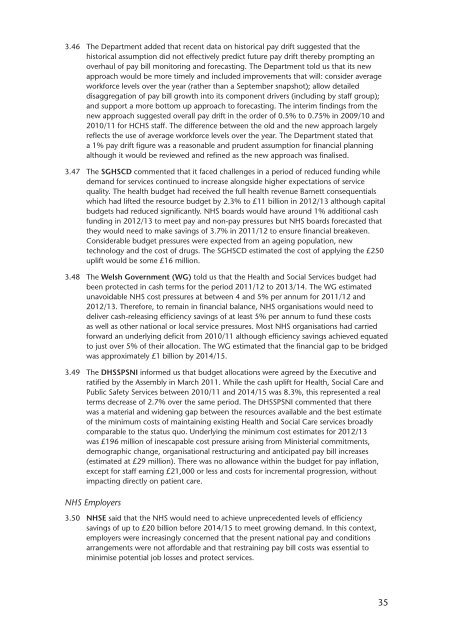NHS pay review body: twenty-sixth report 2012 - Official Documents
NHS pay review body: twenty-sixth report 2012 - Official Documents
NHS pay review body: twenty-sixth report 2012 - Official Documents
Create successful ePaper yourself
Turn your PDF publications into a flip-book with our unique Google optimized e-Paper software.
3.46 The Department added that recent data on historical <strong>pay</strong> drift suggested that the<br />
historical assumption did not effectively predict future <strong>pay</strong> drift thereby prompting an<br />
overhaul of <strong>pay</strong> bill monitoring and forecasting. The Department told us that its new<br />
approach would be more timely and included improvements that will: consider average<br />
workforce levels over the year (rather than a September snapshot); allow detailed<br />
disaggregation of <strong>pay</strong> bill growth into its component drivers (including by staff group);<br />
and support a more bottom up approach to forecasting. The interim findings from the<br />
new approach suggested overall <strong>pay</strong> drift in the order of 0.5% to 0.75% in 2009/10 and<br />
2010/11 for HCHS staff. The difference between the old and the new approach largely<br />
reflects the use of average workforce levels over the year. The Department stated that<br />
a 1% <strong>pay</strong> drift figure was a reasonable and prudent assumption for financial planning<br />
although it would be <strong>review</strong>ed and refined as the new approach was finalised.<br />
3.47 The SGHSCD commented that it faced challenges in a period of reduced funding while<br />
demand for services continued to increase alongside higher expectations of service<br />
quality. The health budget had received the full health revenue Barnett consequentials<br />
which had lifted the resource budget by 2.3% to £11 billion in <strong>2012</strong>/13 although capital<br />
budgets had reduced significantly. <strong>NHS</strong> boards would have around 1% additional cash<br />
funding in <strong>2012</strong>/13 to meet <strong>pay</strong> and non-<strong>pay</strong> pressures but <strong>NHS</strong> boards forecasted that<br />
they would need to make savings of 3.7% in 2011/12 to ensure financial breakeven.<br />
Considerable budget pressures were expected from an ageing population, new<br />
technology and the cost of drugs. The SGHSCD estimated the cost of applying the £250<br />
uplift would be some £16 million.<br />
3.48 The Welsh Government (WG) told us that the Health and Social Services budget had<br />
been protected in cash terms for the period 2011/12 to 2013/14. The WG estimated<br />
unavoidable <strong>NHS</strong> cost pressures at between 4 and 5% per annum for 2011/12 and<br />
<strong>2012</strong>/13. Therefore, to remain in financial balance, <strong>NHS</strong> organisations would need to<br />
deliver cash-releasing efficiency savings of at least 5% per annum to fund these costs<br />
as well as other national or local service pressures. Most <strong>NHS</strong> organisations had carried<br />
forward an underlying deficit from 2010/11 although efficiency savings achieved equated<br />
to just over 5% of their allocation. The WG estimated that the financial gap to be bridged<br />
was approximately £1 billion by 2014/15.<br />
3.49 The DHSSPSNI informed us that budget allocations were agreed by the Executive and<br />
ratified by the Assembly in March 2011. While the cash uplift for Health, Social Care and<br />
Public Safety Services between 2010/11 and 2014/15 was 8.3%, this represented a real<br />
terms decrease of 2.7% over the same period. The DHSSPSNI commented that there<br />
was a material and widening gap between the resources available and the best estimate<br />
of the minimum costs of maintaining existing Health and Social Care services broadly<br />
comparable to the status quo. Underlying the minimum cost estimates for <strong>2012</strong>/13<br />
was £196 million of inescapable cost pressure arising from Ministerial commitments,<br />
demographic change, organisational restructuring and anticipated <strong>pay</strong> bill increases<br />
(estimated at £29 million). There was no allowance within the budget for <strong>pay</strong> inflation,<br />
except for staff earning £21,000 or less and costs for incremental progression, without<br />
impacting directly on patient care.<br />
<strong>NHS</strong> Employers<br />
<strong>NHS</strong>E<br />
3.50 said that the <strong>NHS</strong> would need to achieve unprecedented levels of efficiency<br />
savings of up to £20 billion before 2014/15 to meet growing demand. In this context,<br />
employers were increasingly concerned that the present national <strong>pay</strong> and conditions<br />
arrangements were not affordable and that restraining <strong>pay</strong> bill costs was essential to<br />
minimise potential job losses and protect services.<br />
35
















